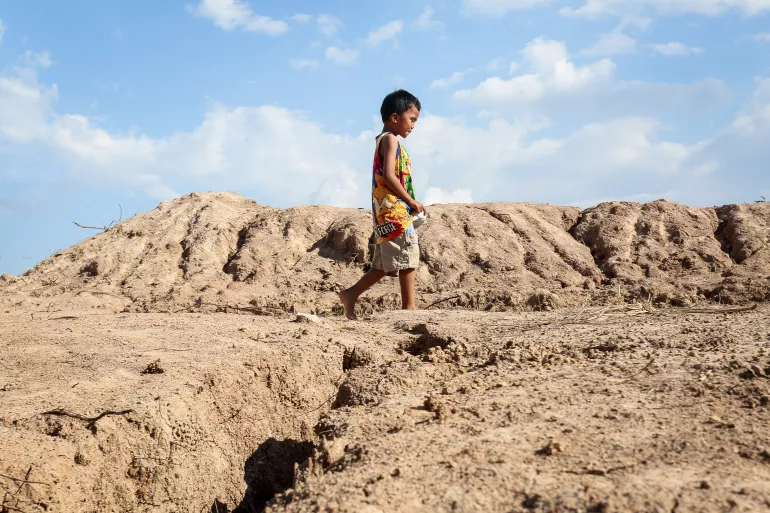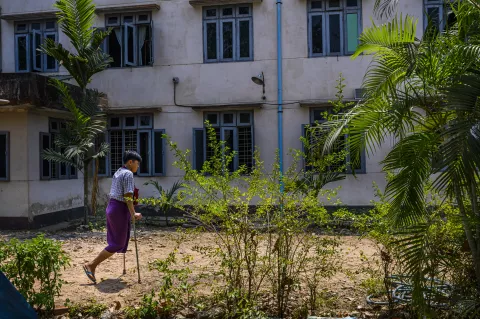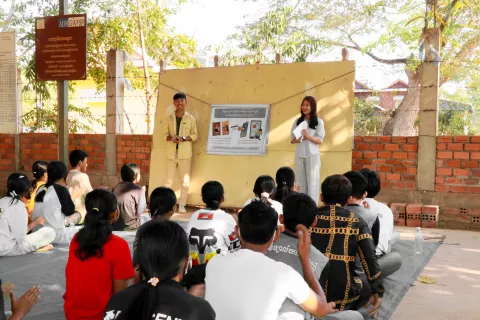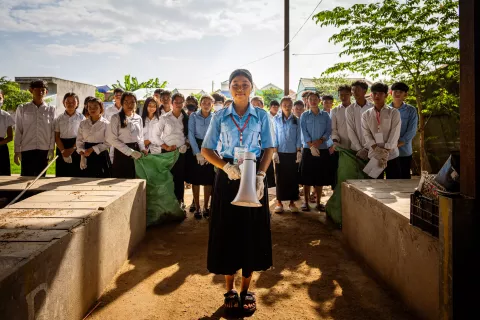Sweltering heat across East Asia and the Pacific puts children’s lives at risk - UNICEF
Rising temperatures pose a threat to the health of over 243 million children in the region

Bangkok, 11 April 2024 – Forecasts of a summer of record heat across East Asia and the Pacific put the lives of millions of children at risk, UNICEF said today.
With scorching 40 degrees Celsius temperatures and high humidity recorded in recent days, and amid warnings over the increasing intensity and frequency of heatwaves over the coming months, the organization says parents and caregivers should take extra precautions to protect children’s health.
UNICEF estimates that across the region, around 243 million children are exposed to hotter and longer heatwaves, putting them at risk of a multitude of heat-related illnesses, and even death.
“Children are more vulnerable than adults to the effects of climate change, and excess heat is a potentially lethal threat to them,” said Debora Comini, Director of UNICEF Regional Office for East Asia and Pacific.
"We must be on high alert this summer to protect children and vulnerable communities from worsening heatwaves and other climate shocks.”
Heatwaves affect children more than adults because they are less able to regulate their body temperature. Young children are at greatest risk of heat-related mortality and illnesses, including chronic respiratory conditions, asthma, and cardiovascular diseases.
Prolonged exposure to intense heat impacts children’s ability to concentrate and learn, putting their education at risk. Extreme heat also increases the likelihood of pregnant women giving birth to premature or stillborn babies, as well as complications from gestational diabetes.
In East Asia and the Pacific, heatwaves are made more deadly by high humidity levels that hinder the body's natural cooling mechanisms.
Concerns over the impact of rising temperatures on children have prompted the Department of Education in the Philippines to suspend in-person classes, while authorities throughout Southeast Asia have been advising people to steer clear of prolonged sun exposure and to be cautious of the risk of heatstroke.
Across East Asia's sprawling urban centers, temperatures often soar above those experienced in rural areas due to the heat-absorbing properties of buildings, roads, and vehicles. With heatwaves intensifying and occurring more frequently, cities are effectively becoming "heat traps" that exacerbate the negative health impacts of high temperatures.
Recent analysis by UNICEF identified the Asia-Pacific as the world’s most disaster-prone region, leading to displacement, school closures, water scarcity, and health risks for children. In October last year, Tropical Cyclone Lola struck Vanuatu, leaving more than 43,000 children in need of humanitarian assistance. In the second half of 2023, El Niño caused a prolonged drought in Kiribati and Tuvalu, triggering water shortages.
According to UNICEF’s projections, by 2050, all of the world’s 2.02 billion children are expected to be exposed to high heatwave frequency, regardless of whether the world achieves a ‘low greenhouse gas emission scenario’ with an estimated 1.7 degrees Celsius of warming in 2050 or a ‘very high greenhouse gas emission scenario’ with an estimated 2.4 degrees Celsius of warming in 2050.
To protect children from this summer’s heatwaves, UNICEF urges frontline workers, parents, families, caregivers and local authorities to protect children and pregnant women by taking the following steps:
- Prevention: At home, school or kindergarten, create cooler places for children to sit or play. Avoid being outdoors during the hot midday and afternoon hours. Make sure that children wear light, breathable clothes, and drink plenty of water throughout the day.
- First aid: If a child or a pregnant woman show symptoms of heat stress (eg dizziness, excessive sweating, nausea, mild fever, nosebleeds, muscle cramps, heath rashes in diaper area), place the person in a cool, shaded area with good ventilation and apply wet towels or cool water to the body. Administer water or Oral Rehydration Salt (ORS). Severe symptoms of heat stress (such as confusion or inability to respond, fainting, high body temperature, rapid heartbeat, seizures and loss of consciousness) require urgent hospital care.
- Look out for your neighbours: Vulnerable families, children with disabilities, pregnant women, and the elderly face a higher risk of illness or death during heatwaves. Take the time to check on your neighbors, especially those who live alone.
#####
Notes to editors
Heatwave: Any period of 3 days or more when the maximum temperature each day is in the top 10 per cent of the local 15-day average.
High heatwave frequency: Where there are on average 4.5 or more heatwaves per year.
High heatwave duration: Where the average heatwave event lasted 4.7 days or longer.
High heatwave severity: Where the average heatwave event is 2°C or more above the local 15-day average.
2050 scenario one: a ‘low greenhouse gas emission scenario’ with an estimated 1.7 degrees of warming by 2050. This is an established scenario used in climate modelling and defined by the IPCC as “SSP1”.
B-roll and photos are available here
Read our heat wave safety tips for more info on how to protect children from heatwaves.
Media contacts
About UNICEF
UNICEF promotes the rights and wellbeing of every child, in everything we do. Together with our partners, we work in 190 countries and territories to translate that commitment into practical action, focusing special effort on reaching the most vulnerable and excluded children, to the benefit of all children, everywhere.
For more information about UNICEF East Asia & Pacific and its work for children, visit www.unicef.org/eap
Follow UNICEF East Asia & Pacific on Twitter , Facebook, Instagram, and LinkedIn





